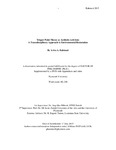Trigger Point Theory as Aesthetic Activism
| dc.contributor.supervisor | Rahmani, Aviva | |
| dc.contributor.author | Rahmani, Aviva | |
| dc.contributor.other | Faculty of Arts, Humanities and Business | en_US |
| dc.date.accessioned | 2017-05-24T10:23:47Z | |
| dc.date.available | 2017-05-24T10:23:47Z | |
| dc.date.issued | 2015 | |
| dc.identifier | 10252910 | en_US |
| dc.identifier.uri | http://hdl.handle.net/10026.1/9326 | |
| dc.description | File replaced in PEARL - file size reduced on 15.02.19 by LW (TIS). | |
| dc.description.abstract |
Trigger Point Theory as Aesthetic Activism: A Transdisciplinary Approach to Environmental Restoration Aviva A. Rahmani This dissertation presents a new approach to addressing environmental degradation based on transdisciplinary ecological art. Transdisciplinarity is defined here as merging art and science to discover new insights. Ecological art is defined as an aesthetic practice that promotes environmental resilience. This writing will describe why those approaches are essential to restoring resilient bioregionalism. It introduces the author’s own heuristic perspectives and methodologies and demonstrates how they may be integrated with technology and science. The problems of accelerated loss of coastal (littoral) zone biodiversity, degraded water quality, and habitat fragmentation need critical attention. The author’s research goal was to present a replicable set of guidelines for identifying small points of restoration for wetland littoral zones (the coastal region between terrestrial and marine life) based on a case study called Ghost Nets, scaled to a second case study, Fish Story. Her novel approach included establishing relevant parallels from quantum physics and acupuncture to energetic systems. Additional specific analogies were explored from visual arts, theatre, music, dance, and performance art, to discover a holistic and integrated point of view. Parallels and analogies were drawn by interrogating the two case studies. An important aim of the study was to examine how certain restoration practices could be scaled up to the bioregional level and integrated with a special theory, Trigger Point Theory, to reinforce healthy ecosystems. This included an analysis of how restored upland ecotones and a different relationship to other species could contribute to restoration in the littoral zone. The analysis critiqued how anthropocentric considerations often fail to protect vulnerable water systems. The role of environmental justice for vulnerable human populations and ethical concerns for other animal species was included in that analysis. The author also claims that when artists work with Geographic Information Systems (GIS) mapping, that may propel a new transdiscourse and eventually make heuristic information scientifically useful. Insight from the Ghost Nets case study informed data collections and GIS mapping for the Southern Gulf of Maine. Those insights and the mapping were used to analyze relationships between finfish abundance, eelgrass, and invasive, predatory green crabs. Conclusions were drawn that are relevant to coastal and fisheries management practices. The author used performative approaches to contribute expert witnessing to her conclusions. Questionnaires were used to determine how much community awareness was accomplished with the case studies, and assess effects on future behavior. By combining art and science methodologies, the author revealed insights that could help small restored sites act as trigger points towards restoration of healthy bioregional systems more efficiently than would be possible through restoration science alone. In scaling up (applying small models to larger systems) and applying these practices for landscape ecology, the author assembled a set of recommendations for other researchers to implement these ideas in the future. Those recommendations included the formal engagement of ecological artists as equal partners on environmental restoration teams. | en_US |
| dc.language.iso | en | en_US |
| dc.publisher | Plymouth University | en_US |
| dc.subject | Anthropocene | en_US |
| dc.subject | Transdisciplinary | |
| dc.subject | Restoration | |
| dc.subject | Ecological Art | |
| dc.subject | Environmental Crisis | |
| dc.subject | Ecosystem | |
| dc.subject | Landscape Ecology | |
| dc.subject | Modeling | |
| dc.subject.classification | PhD | en_US |
| dc.title | Trigger Point Theory as Aesthetic Activism | en_US |
| dc.type | Thesis | |
| plymouth.version | Edited version | en_US |
| dc.identifier.doi | http://dx.doi.org/10.24382/4374 |
Files in this item
This item appears in the following Collection(s)
-
01 Research Theses Main Collection
Research Theses Main



